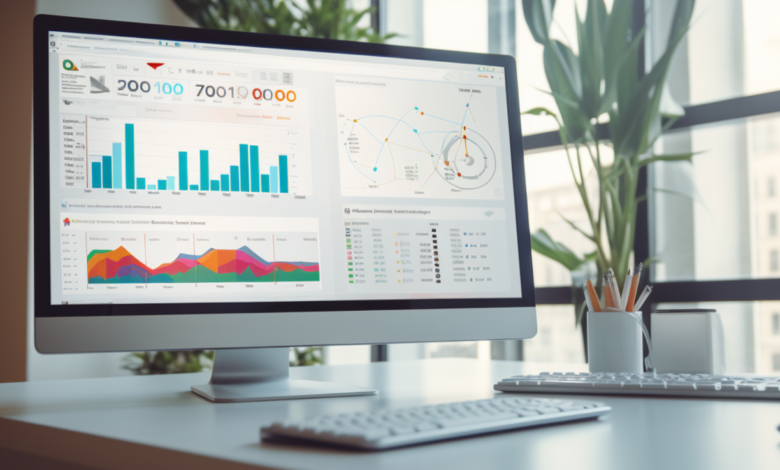Unleashing the Future: Programmatic Marketing for Healthcare Providers

The Evolution of Digital Marketing in Healthcare
As the healthcare industry continues to evolve, so too does its approach to marketing. Today, digital marketing is no longer just an optional strategy but an essential part of reaching and engaging with both patients and healthcare professionals. The rise of programmatic marketing for healthcare providers has significantly reshaped how pharmaceutical marketers and agencies operate.
Traditional Marketing vs. Programmatic Marketing
Traditional marketing methods, such as direct mail, print advertising, and television commercials, often involve a broad, one-size-fits-all approach to reaching audiences. These strategies, while still relevant, tend to lack the precision and customization that today’s consumers demand.
In contrast, programmatic marketing leverages technology to automate and optimize the ad buying process. It uses real-time data to target specific audiences, resulting in more personalized and effective campaigns. This data-driven approach allows healthcare providers to reach their desired audiences, including patients and healthcare professionals, with the right message at the right time. For a deeper dive into programmatic marketing, visit our article on programmatic marketing for healthcare.
The Importance of Data-Driven Strategies
In today’s digital age, data is the cornerstone of effective marketing. By harnessing the power of data, healthcare providers can gain valuable insights into their audience’s behaviors, preferences, and needs. These insights can inform marketing strategies, helping to create personalized and relevant campaigns that resonate with the target audience.
Programmatic marketing takes data-driven strategies to the next level. It uses sophisticated algorithms to analyze and interpret large volumes of data in real-time, allowing for advanced audience segmentation and targeting. This not only improves the efficiency and effectiveness of marketing campaigns but also provides measurable results that can inform future strategies.
The shift towards data-driven strategies signifies the growing importance of programmatic marketing for healthcare providers. Leveraging these strategies can help healthcare providers better connect with their target audiences, ultimately improving patient outcomes and driving business growth. To learn more about how to leverage programmatic marketing to reach patients and healthcare professionals, check out our articles on reaching patients through programmatic marketing and programmatic advertising strategies for hcps.
By understanding the evolution of digital marketing in the healthcare industry and the role of programmatic marketing, healthcare providers can better navigate the digital landscape and create more effective, data-driven marketing strategies.
Understanding Programmatic Marketing
For healthcare providers looking to enhance their digital marketing strategies, understanding programmatic marketing is key. This section delves into what programmatic marketing is, the role automation plays in it, and the power of real-time bidding.
Programmatic Marketing Defined
Programmatic marketing is an automated method of buying and selling digital advertising. It involves leveraging technology to purchase digital ad space, as opposed to traditional methods that require manual negotiations and insertion orders. This approach allows for more precise and efficient ad placements, thus making it a powerful tool in the realm of digital marketing for healthcare providers.
The Role of Automation in Programmatic Marketing
Automation is at the heart of programmatic marketing. It eliminates the time-consuming process of manual ad buying and placement, replacing it with a system that uses algorithms to determine where and when to place ads. This automation allows for the optimization of campaigns in real-time based on performance data.
Automated bidding, audience segmentation, and ad placement are all part of the automation process in programmatic marketing. For healthcare providers, this automation can enhance the efficiency of their marketing efforts, allowing them to reach their target audience — whether that’s patients or healthcare professionals — more effectively. Learn more about programmatic marketing for healthcare professionals in our related article.
The Power of Real-Time Bidding
Real-time bidding (RTB) is a key element of programmatic marketing. It is a method of selling and buying ad space on a per-impression basis, via an instantaneous auction. This process occurs in the time it takes a webpage to load, making it a highly efficient way to purchase ad space.
The advantage of RTB for healthcare providers is that it allows them to bid on ad space based on the specific attributes of the audience they want to reach. This maximizes the relevance of the ads served, improving engagement and conversion rates.
For more insights on how healthcare providers can leverage programmatic marketing to reach their target audience, explore our article on reaching patients through programmatic marketing.
By understanding the dynamics of programmatic marketing, healthcare providers can unlock new opportunities in their digital marketing strategies. From automation to real-time bidding, these elements offer powerful ways to reach and engage with their desired audience in the digital age.
Benefits of Programmatic Marketing for Healthcare Providers
The use of programmatic marketing is transforming the healthcare industry, offering numerous benefits for healthcare providers. By leveraging data-driven insights and automation, programmatic marketing allows healthcare providers to effectively target patients and healthcare professionals (HCPs), improve efficiency, and track campaign performance with enhanced metrics and analytics.
Enhanced Targeting Capabilities
One of the primary advantages of programmatic marketing for healthcare providers is the ability to enhance targeting capabilities. Through the use of data and advanced algorithms, healthcare providers can identify and target specific patient and HCP segments based on a variety of factors, such as demographics, behaviors, and medical history.
This precision targeting allows healthcare providers to deliver relevant and personalized messages to their audiences, improving engagement and conversion rates. It also enables healthcare providers to reach their target audiences at the right time, on the right platform, and with the right message, maximizing the impact of their marketing efforts. For more insights on reaching patients through programmatic marketing, visit our article on reaching patients through programmatic marketing.
Greater Efficiency and Cost-Effectiveness
Programmatic marketing also enhances efficiency and cost-effectiveness. By automating the buying and selling of digital advertising, programmatic marketing eliminates the need for manual processes and negotiations, saving time and resources.
Furthermore, the use of real-time bidding allows healthcare providers to optimize their ad spend, ensuring that they are getting the best value for their investment. By bidding on ad space in real-time, healthcare providers can adjust their strategies based on the performance of their campaigns, maximizing their return on investment.
Lastly, the ability to target specific audiences reduces wasted impressions, as ads are only shown to individuals who are likely to be interested in the healthcare provider’s offerings. This level of efficiency and cost-effectiveness is particularly beneficial for healthcare providers operating with limited marketing budgets.
Improved Metrics and Analytics
Finally, programmatic marketing provides healthcare providers with improved metrics and analytics. With programmatic marketing, healthcare providers can track a variety of key performance indicators (KPIs), such as click-through rates, conversion rates, and return on ad spend.
These metrics provide valuable insights into the effectiveness of marketing campaigns, allowing healthcare providers to identify what is working and what isn’t. This data-driven approach enables healthcare providers to continually refine and optimize their marketing strategies, ensuring that they are achieving their desired outcomes.
Moreover, the ability to track metrics in real-time allows healthcare providers to react quickly to changes in campaign performance, making necessary adjustments to optimize results. For a detailed discussion on programmatic advertising strategies for HCPs, have a look at our article on programmatic advertising strategies for HCPs.
By leveraging the benefits of programmatic marketing, healthcare providers can enhance their marketing efforts, reaching more potential patients and HCPs, improving efficiency and cost-effectiveness, and gaining valuable insights into campaign performance. As the healthcare landscape continues to evolve, the importance of programmatic marketing for healthcare providers is set to grow even further.
Challenges and Considerations in Programmatic Marketing for Healthcare
While programmatic marketing for healthcare providers offers numerous benefits, it’s also accompanied by certain challenges and considerations. These primarily include addressing privacy concerns, navigating regulatory compliance, and managing data quality and integrity.
Addressing Privacy Concerns
In the era of data-driven marketing, privacy stands as a critical concern. For healthcare providers employing programmatic marketing tactics, it’s essential to ensure the sensitive health information of patients is adequately protected.
Healthcare marketers must balance the need for personalized communication with the obligation to protect patient information. They should ensure data collection and usage practices are transparent and opt-in whenever possible. More so, implementing robust data security measures can help prevent unauthorized access or data breaches.
For more tips on maintaining patient privacy in programmatic marketing, visit our article on reaching patients through programmatic marketing.
Navigating Regulatory Compliance
The healthcare industry is heavily regulated, and that extends to the realm of digital marketing. Healthcare providers and marketers must be aware of regulations such as the Health Insurance Portability and Accountability Act (HIPAA) in the U.S. or the General Data Protection Regulation (GDPR) in Europe.
These regulations dictate the ways in which patient data can be collected, stored, and used for marketing purposes. Non-compliance can lead to severe penalties and damage to the organization’s reputation. As such, it’s crucial to stay updated with regulatory changes and ensure all marketing activities are compliant.
Understanding the regulations applicable to programmatic marketing in healthcare can be complex. For more guidance, refer to our article on programmatic marketing for healthcare professionals.
Managing Data Quality and Integrity
In programmatic marketing, the quality of the data collected and used significantly impacts the effectiveness of the campaigns. Poor data quality can lead to ineffective targeting, wasted ad spend, and miscommunication with patients.
Healthcare providers should have in place procedures for regular data auditing, cleaning, and updating. This helps to ensure that the information used for programmatic marketing is accurate, relevant, and up-to-date.
Beyond the quality, the integrity of the data is equally important. This means that the data should be reliable and consistent across various platforms and tools used for marketing.
For advice on maintaining data quality and integrity in programmatic marketing, check out our article on targeting patients through programmatic marketing.
In conclusion, while programmatic marketing holds great promise for healthcare providers, it’s not without its challenges. By addressing privacy concerns, navigating regulatory compliance, and managing data quality and integrity, healthcare providers can leverage the power of programmatic marketing while mitigating potential risks.
Programmatic Marketing Trends in Healthcare
The dynamic world of programmatic marketing for healthcare providers is continually evolving, with new trends emerging that are set to reshape the industry. Three notable trends include the rise of mobile and video advertising, the impact of artificial intelligence and machine learning, and the shift towards personalized patient engagement.
The Rise of Mobile and Video Advertising
The use of mobile and video advertising in programmatic marketing is on the rise in the healthcare industry. With the majority of consumers now accessing health information through their smartphones, mobile platforms offer a powerful channel for reaching patients and healthcare professionals (HCPs). Similarly, video advertising provides a compelling medium to engage audiences, convey complex health information, and build brand awareness.
According to recent data, mobile ad spending is projected to account for over 70% of total programmatic ad spend in the healthcare sector, emphasizing the growing importance of mobile platforms for patient and HCP outreach.
| Year | Mobile Ad Spend | Video Ad Spend |
|---|---|---|
| 2019 | 60% | 30% |
| 2020 | 65% | 35% |
| 2021 | 70% | 40% |
For more insights on reaching patients through mobile and video advertising, refer to our article on reaching patients through programmatic marketing.
The Impact of Artificial Intelligence and Machine Learning
Artificial intelligence (AI) and machine learning (ML) are revolutionizing programmatic marketing in the healthcare sector. These technologies enhance targeting capabilities, optimize ad spend, and provide more sophisticated analytics, offering new opportunities for healthcare providers to engage with their audience.
AI and ML algorithms can analyze vast amounts of data to identify patterns, predict user behavior, and deliver personalized ads at the right time and place. This enables healthcare providers to optimize their programmatic advertising strategies and achieve better results. For more information on leveraging AI and ML in programmatic marketing, check out our article on programmatic marketing for healthcare professionals.
The Shift towards Personalized Patient Engagement
Personalization is becoming increasingly important in programmatic marketing for healthcare providers. By tailoring ads to individual preferences, needs, and behaviors, healthcare providers can enhance patient engagement and build stronger relationships.
This shift towards personalized patient engagement is driven by advanced data analytics and segmentation capabilities. These technologies allow healthcare providers to develop a deep understanding of their audience and deliver highly relevant content that resonates with patients and HCPs.
Personalized programmatic marketing strategies not only improve campaign performance but also enhance patient experience and satisfaction. For more insights on personalized patient engagement, refer to our article on targeting patients through programmatic marketing.
These trends underscore the dynamic nature of programmatic marketing in the healthcare sector. By keeping abreast of these trends and adapting their strategies accordingly, healthcare providers can leverage programmatic marketing to effectively reach and engage their target audience.
Implementing Programmatic Marketing Strategies for Healthcare Providers
To fully harness the potential of programmatic marketing for healthcare providers, a comprehensive approach encompassing various elements is necessary. Here are some key strategies to consider.
Developing a Data-Driven Approach
In the realm of programmatic marketing, data serves as the guiding force. It’s crucial to build a data-driven approach, focusing on collecting relevant, actionable insights about your target audiences, be they patients or healthcare professionals (HCPs). Analysis of these data sets allows for more precise targeting, personalized messaging, and ultimately, more effective marketing campaigns.
But how do you develop a data-driven approach? Begin by identifying the key metrics that align with your marketing goals. This could range from demographic data like age and location to behavioural data like browsing patterns and medical interests. Next, integrate analytics tools to collect and analyze these data points. This will provide you with valuable insights that can shape your programmatic marketing strategies.
Building Effective Patient and HCP Segments
Segmentation is a vital step in programmatic marketing. By dividing your target audience into distinct groups or ‘segments’ based on shared characteristics or behaviours, you can tailor your marketing messages to resonate with each group effectively.
When building segments for patients, consider factors like medical conditions, treatment history, and health interests. For HCPs, look at their specialties, prescribing behaviours, or preferred platforms for medical information.
Effective segmentation enables you to deliver the right message to the right audience at the right time, thereby enhancing the impact of your programmatic marketing for healthcare professionals.
Leveraging the Right Programmatic Platforms and Tools
The success of your programmatic marketing efforts heavily relies on the platforms and tools you utilize. It’s important to choose those that offer advanced targeting capabilities, robust data analytics, and compliance with healthcare regulations.
Look for platforms that integrate seamlessly with your existing marketing stack, and that can efficiently handle real-time bidding and ad placements. Additionally, consider tools that offer advanced features like predictive analytics and artificial intelligence, which can further optimize your campaigns.
Measuring and Optimizing Campaign Performance
The beauty of programmatic marketing lies in its measurability. By tracking key performance indicators (KPIs) like click-through rates, conversion rates, and cost per acquisition, you can gain a clear understanding of what’s working and what’s not in your campaigns.
Use these insights to continuously refine and optimize your strategies. This could mean adjusting your bidding strategies, tweaking your audience segments, or experimenting with different types of ad creatives. The goal is to ensure that your programmatic marketing efforts are delivering the best possible results.
Implementing programmatic marketing for healthcare providers is not without its challenges, but with the right approach, the benefits are significant. From enhanced audience targeting to improved cost-efficiency and analytics, programmatic marketing is reshaping the way healthcare providers connect with their audiences. For more insights on this topic, visit our guide on reaching patients through programmatic marketing.





